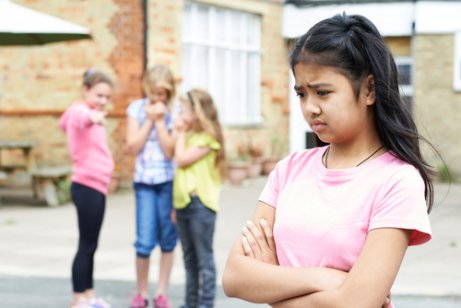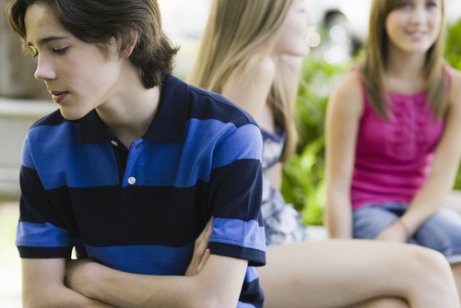Peer Rejection: The Problem With Excluded Children

One of the greatest challenges that children face is the construction of personal relationships with their peers. This socialization boosts social and psychological development in children. It provides them with stability, intimacy, protection and emotional support.
However, this learning process is sometimes hindered by peer rejection. Unfortunately, this is an every growing problem.
What is peer rejection?
Basically, peer rejection is a type of repudiation that an individual suffers from his or her peers. In general, the individual experience dislike, snubbing, and lack of self-esteem. These attitudes are reflected in certain changes in behavior.
It is the opposite of social acceptance, where an individual experiences love and recognition and is sought out by his or her peers.
“Peer rejection is a type of repudiation that an individual suffers from his or her peers”
Reasons why peer rejection occurs
Rejection is a complex attitude that demands an approach from a point of view that promotes acceptance. The following factors tend to precede peer rejection:
- The rejected child’s behavior. Generally, the child is one who doesn’t control his or her physical or verbal impulses. For example, the child may sometimes hurt the rest of the group.
- Constant justification of the child’s attitudes. He or she may, on occasion, blame another for his or her actions. This only reinforces the peer rejection.
- Frustration on behalf of the rejected individual. This combines with depression, hostility, isolation, and other consequences.
- Shy children who belong to different social, racial or ethnic groups.
The process of rejection involves variables that aren’t only limited to the attitudes of the rejected child. It’s a situation where all of the parties in the child’s environment are involved – teachers, family members, and classmates.
When children are excluded, they lose the opportunity to establish positive relationships and develop abilities that stimulate their social and psychological growth.

How can you tell if a child is the victim of peer rejection?
An estimated 15% of children suffer from peer rejection. This can sometimes lead to bullying. Detecting that a child is going through this situation will help prevent future consequences.
The most frequent attitudes in excluded children are the following:
- Aggressive or bothersome behavior that makes interaction with the rest of the group difficult.
- Anxious and impulsive behavior that leads the child to get angry quickly or easily.
- Tantrums, lack of attention and frequent impertinences.
- Isolation, withdrawal and shyness.
- Very small children are prone to crying. They may fake physical discomfort or beg not to have to go to school.
Consequences of peer rejection
The consequences of peer rejection can develop over time. Here are some examples:
Short-term consequences
Being a victim of peer rejection can leave psychological side effects that affect a person’s interpersonal experiences. It can cause a loss of interest in activities that the person used to find appealing. The child may also develop a lack of self-appreciation.
Peer rejection can also lead to anxiety, depression, eating disorders, emotional disorders, and more.
“An estimated 15% of children suffer from peer rejection”
Mid-term consequences
If the attitudes aren’t addressed in time, the situation will become serious. This allows fear of school activities to become habitual, leading to low academic performance and high chances of failure.
Rejected children also develop a distorted self-image, which leads to depression, as well as aggressive and self-destructive reactions.
On a social level, children develop a distrust that impedes their socialization with friends, including close family. In this regards, the rejected child becomes a victim and needs immediate help.

Long-term consequences
Over time, rejection destroys self-esteem and encourages aggression. The affected individual demonstrates the following attitudes:
- Absence from school or work.
- Vandalism, robbery, drug addiction and delinquency.
- Suicidal thoughts and social isolation.
- Nervousness, anxiety and generalized fear.
- Tendency towards experiencing rejection at any age.
How to respond in the face of peer rejection
As parents, guardians or educators, it’s best to evaluate the cause of the rejection and take immediate action. All of the involved parties should be included in the solution in order to encourage inclusion and cooperative learning.
In the same way, adults should offer tools to help the child effectively include him or herself in groups without being rejected.
In conclusion, peer rejection is a situation that can cause long-term problems such as anxiety and depression. Acting quickly can prevent future consequences. It’s important that parents stimulate their child’s social and psychological development.
One of the greatest challenges that children face is the construction of personal relationships with their peers. This socialization boosts social and psychological development in children. It provides them with stability, intimacy, protection and emotional support.
However, this learning process is sometimes hindered by peer rejection. Unfortunately, this is an every growing problem.
What is peer rejection?
Basically, peer rejection is a type of repudiation that an individual suffers from his or her peers. In general, the individual experience dislike, snubbing, and lack of self-esteem. These attitudes are reflected in certain changes in behavior.
It is the opposite of social acceptance, where an individual experiences love and recognition and is sought out by his or her peers.
“Peer rejection is a type of repudiation that an individual suffers from his or her peers”
Reasons why peer rejection occurs
Rejection is a complex attitude that demands an approach from a point of view that promotes acceptance. The following factors tend to precede peer rejection:
- The rejected child’s behavior. Generally, the child is one who doesn’t control his or her physical or verbal impulses. For example, the child may sometimes hurt the rest of the group.
- Constant justification of the child’s attitudes. He or she may, on occasion, blame another for his or her actions. This only reinforces the peer rejection.
- Frustration on behalf of the rejected individual. This combines with depression, hostility, isolation, and other consequences.
- Shy children who belong to different social, racial or ethnic groups.
The process of rejection involves variables that aren’t only limited to the attitudes of the rejected child. It’s a situation where all of the parties in the child’s environment are involved – teachers, family members, and classmates.
When children are excluded, they lose the opportunity to establish positive relationships and develop abilities that stimulate their social and psychological growth.

How can you tell if a child is the victim of peer rejection?
An estimated 15% of children suffer from peer rejection. This can sometimes lead to bullying. Detecting that a child is going through this situation will help prevent future consequences.
The most frequent attitudes in excluded children are the following:
- Aggressive or bothersome behavior that makes interaction with the rest of the group difficult.
- Anxious and impulsive behavior that leads the child to get angry quickly or easily.
- Tantrums, lack of attention and frequent impertinences.
- Isolation, withdrawal and shyness.
- Very small children are prone to crying. They may fake physical discomfort or beg not to have to go to school.
Consequences of peer rejection
The consequences of peer rejection can develop over time. Here are some examples:
Short-term consequences
Being a victim of peer rejection can leave psychological side effects that affect a person’s interpersonal experiences. It can cause a loss of interest in activities that the person used to find appealing. The child may also develop a lack of self-appreciation.
Peer rejection can also lead to anxiety, depression, eating disorders, emotional disorders, and more.
“An estimated 15% of children suffer from peer rejection”
Mid-term consequences
If the attitudes aren’t addressed in time, the situation will become serious. This allows fear of school activities to become habitual, leading to low academic performance and high chances of failure.
Rejected children also develop a distorted self-image, which leads to depression, as well as aggressive and self-destructive reactions.
On a social level, children develop a distrust that impedes their socialization with friends, including close family. In this regards, the rejected child becomes a victim and needs immediate help.

Long-term consequences
Over time, rejection destroys self-esteem and encourages aggression. The affected individual demonstrates the following attitudes:
- Absence from school or work.
- Vandalism, robbery, drug addiction and delinquency.
- Suicidal thoughts and social isolation.
- Nervousness, anxiety and generalized fear.
- Tendency towards experiencing rejection at any age.
How to respond in the face of peer rejection
As parents, guardians or educators, it’s best to evaluate the cause of the rejection and take immediate action. All of the involved parties should be included in the solution in order to encourage inclusion and cooperative learning.
In the same way, adults should offer tools to help the child effectively include him or herself in groups without being rejected.
In conclusion, peer rejection is a situation that can cause long-term problems such as anxiety and depression. Acting quickly can prevent future consequences. It’s important that parents stimulate their child’s social and psychological development.
All cited sources were thoroughly reviewed by our team to ensure their quality, reliability, currency, and validity. The bibliography of this article was considered reliable and of academic or scientific accuracy.
- Estévez, E., Martínez, B., Moreno, D., & Musitu, G. (2006). Relaciones familiares, rechazo entre iguales y violencia escolar. Cultura y Educación, 18(3-4), 335-344. https://www.tandfonline.com/doi/abs/10.1174/113564006779173046
- García-Bacete, F. J., Carrión, A. L., & Casares, M. I. M. (2005). ¿ Por qué los niños no quieren jugar con otros niños? Un análisis exploratorio de los motivos de rechazo entre iguales. International Journal of Developmental and Educational Psychology, 1(1), 257-268. https://www.redalyc.org/pdf/3498/349832486018.pdf
- García Bacete, F. J., Sureda García, I., & Monjas Casares, I. (2010). El rechazo entre iguales en la educación primaria: Una panorámica general. Anales de psicología. https://digitum.um.es/digitum/handle/10201/14481
- Martín, E., & De Bustillo, M. C. M. (2009). Un análisis contextual de la preferencia y el rechazo entre iguales en la escuela. Psicothema, 21(3), 439-445. https://www.redalyc.org/pdf/727/72711821016.pdf
This text is provided for informational purposes only and does not replace consultation with a professional. If in doubt, consult your specialist.








